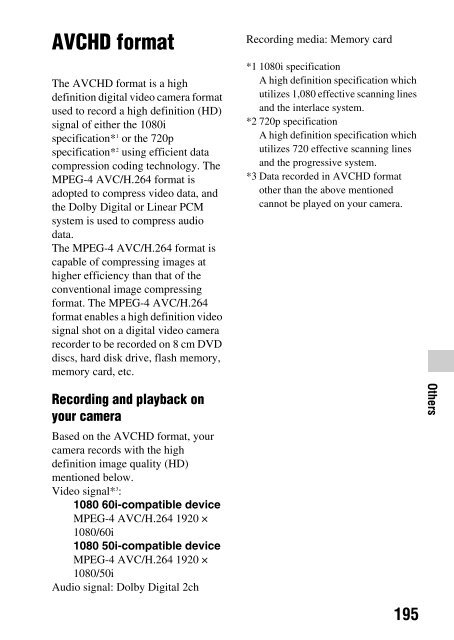Sony SLT-A33 - SLT-A33 Consignes d’utilisation Anglais
Sony SLT-A33 - SLT-A33 Consignes d’utilisation Anglais
Sony SLT-A33 - SLT-A33 Consignes d’utilisation Anglais
You also want an ePaper? Increase the reach of your titles
YUMPU automatically turns print PDFs into web optimized ePapers that Google loves.
GPS (<strong>SLT</strong>-A55V<br />
only)<br />
This system allows you to pinpoint<br />
your exact location on the earth. The<br />
GPS satellites are located in 6 orbits,<br />
20,000 km above the earth. The GPS<br />
system consists of 24 or more GPS<br />
satellites. A GPS receiver receives<br />
radio signals from the satellites, and<br />
calculates the current location of the<br />
receiver based on the orbital<br />
information (almanac data) and travel<br />
time of the signals, etc.<br />
Determining a location is called<br />
“triangulating.” A GPS receiver can<br />
determine the location’s latitude and<br />
longitude by receiving signals from 3<br />
or more satellites.<br />
• As the positions of GPS satellites<br />
vary constantly, it may take longer<br />
to determine the location or the<br />
receiver may not be able to<br />
determine the location at all,<br />
depending on the location and time<br />
you use the camera.<br />
• “GPS” is a system for determining<br />
geographic location by<br />
triangulating radio signals from<br />
GPS satellites. Avoid using the<br />
camera in places where radio<br />
signals are blocked or reflected,<br />
such as a shadowy place<br />
surrounded by buildings or trees,<br />
etc. Use the camera in open sky<br />
environments.<br />
• You may not be able to record<br />
location information at locations or<br />
in situations where radio signals<br />
from the GPS satellites do not reach<br />
the camera as follows.<br />
– In tunnels, indoors or under the<br />
shade of buildings.<br />
– Between tall buildings or at<br />
narrow streets surrounded by<br />
buildings.<br />
– In underground locations,<br />
locations surrounded by dense<br />
trees, under an elevated bridge, or<br />
in locations where magnetic fields<br />
are generated, such as near high<br />
voltage cables.<br />
– Near devices that generate radio<br />
signals of the same frequency<br />
band as the camera: near 1.5 GHz<br />
band mobile telephones, etc.<br />
On triangulating errors<br />
• If you move to another location<br />
right after turning on the camera, it<br />
may take a longer time for the<br />
camera to start triangulating,<br />
compared to when you stay in the<br />
same place.<br />
• If triangulating fails, previouslytriangulated<br />
location information<br />
may be written onto the image in<br />
the camera.<br />
• Error caused by the position of GPS<br />
satellites<br />
The camera automatically<br />
triangulates your current location<br />
when the camera receives radio<br />
signals from 3 or more GPS<br />
satellites. The triangulating error<br />
allowed by the GPS satellites is<br />
about 30 m (98 feet). Depending on<br />
the environment of the location, the<br />
triangulating error can be greater. In<br />
this case, your actual location may<br />
196
















